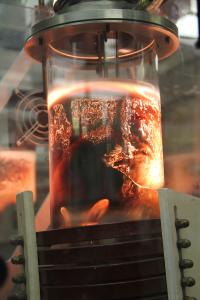Oct 26 2012
Recycling keeps paper, plastics, and even jeans out of landfills. Could recycling rare-earth magnets do the same? Perhaps, if the recycling process can be improved.
 Rare-earth magnet scraps are melted in a furnace with magnesium. Scientists at the US Department of Energy's Ames Laboratory are improving the process to reclaim rare-earth materials. Credit: Ames Laboratory -- USDOE
Rare-earth magnet scraps are melted in a furnace with magnesium. Scientists at the US Department of Energy's Ames Laboratory are improving the process to reclaim rare-earth materials. Credit: Ames Laboratory -- USDOE
Scientists at the U.S. Department of Energy's (DOE) Ames Laboratory are working to more effectively remove the neodymium, a rare earth element, from the mix of other materials in a magnet. Initial results show recycled materials maintain the properties that make rare-earth magnets useful.
The current rare earth recycling research builds on Ames Laboratory's decades of rare-earth processing experience. In the 1990s, Ames Lab scientists developed a process that uses molten magnesium to remove rare earths from neodymium-iron-boron magnet scrap. Back then, the goal was to produce a mixture of magnesium and neodymium because the neodymium added important strength to the alloy, rather than separate out high-purity rare earths because, at the time, rare earth prices were low.
But rare earth prices increased ten-fold between 2009 and 2011 and supplies are in question. Therefore, the goal of today's rare-earth recycling research takes the process one step farther.
"Now the goal is to make new magnet alloys from recycled rare earths. And we want those new alloys to be similar to alloys made from unprocessed rare-earth materials," said Ryan Ott, the Ames Laboratory scientist leading the research. "It appears that the processing technique works well. It effectively removes rare earths from commercial magnets."
Ott's research team also includes Ames Laboratory scientist Larry Jones and is funded through a work for others agreement with the Korea Institute of Industrial Technology. The research group is developing and testing the technique in Ames Lab's Materials Preparation Center, with a suite of materials science tools supported by the DOE Office of Science.
"We start with sintered, uncoated magnets that contain three rare earths: neodymium, praseodymium and dysprosium," said Ott. "Then we break up the magnets in an automated mortar and pestle until the pieces are 2-4 millimeters long.
Next, the tiny magnet pieces go into a mesh screen box, which is placed in a stainless-steel crucible. Technicians then add chunks of solid magnesium.
A radio frequency furnace heats the material. The magnesium begins to melt, while the magnet chunks remain solid.
"What happens then is that all three rare earths leave the magnetic material by diffusion and enter the molten magnesium," said Ott. "The iron and boron that made up the original magnet are left behind."
The molten magnesium and rare-earth mixture is cast into an ingot and cooled. Then they boil off the magnesium, leaving just the rare earth materials behind.
"We've found that the properties of the recycled rare earths compare very favorably to ones from unprocessed materials," said Ott. "We're continuing to identify the ideal processing conditions."
The next step is optimizing the extraction process. Then the team plans to demonstrate it on a larger scale.
"We want to help bridge the gap between the fundamental science and using this science in manufacturing," said Ott. "And Ames Lab can process big enough amounts of material to show that our rare-earth recycling process works on a large scale."
The Ames Laboratory is a U.S. Department of Energy Office of Science national laboratory operated by Iowa State University. The Ames Laboratory creates innovative materials, technologies and energy solutions. We use our expertise, unique capabilities and interdisciplinary collaborations to solve global problems.